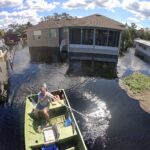The arcane world of spies, informers, terrorists and the people who have to deal with them remains largely a mystery to most ordinary citizens. But when those efforts produce spectacular results, as in the tracking down and killing of Osama bin Laden, it shines a spotlight on how they operate.
A bulletin from Risk Management Solutions points out that “as with all ranks of terrorists, finding him ultimately rested on contacts within his social network. U.S. intelligence services have long attempted to track individuals who might be in his network. Tracking a courier finally led to a compound in northwest Pakistan, where the Al Qaeda leader was found and killed.”
RMS also noted that “the analytical process of identifying terrorist social network links has been successful in thwarting all but a few plots against the western alliance since 9/11, despite the high Jihadi threat level.”
RMS “catastrophist,” Dr. Gordon Woo explained: “In the asymmetric war with terrorists, the forces of the state have a vast superiority in the domain of communications security – except in countries such as Pakistan, where the security services are compromised.
“Because the Pakistani Inter-Services Intelligence organization, ISI, has a tradition of actively supporting and encouraging the Jihad to liberate Kashmir from Indian rule, Jihadis in Pakistan are largely unconstrained in their manifold terrorist activities. Therefore, it is not surprising that Osama bin Laden should have found sanctuary amidst the Pakistan military establishment.”
RMS described Pakistan as “a country that supports terrorism.” While – is plagued by endemic terrorism – might be a better way to describe it, the country’s vulnerability to terrorist attacks stands in sharp contrast to the U.S., which, RMS noted, “has strict security focuses aimed at both foiling and preventing these attacks. In 2010, there were more than a thousand significant terrorist incidents in Pakistan – typically more than a hundred each month.
“Over the past ten years, there have been numerous failed and foiled terrorist attempts which were identified by U.S. intelligence through social network analysis, such as the Times Square Bombing.”
RMS also indicated that the ability to spot and avoid potential terrorist attacks validates its “theory of social networking analysis, which is reflected in the RMS® U.S. Probabilistic Terrorism Model.” However, just because bin Laden is out of the picture, doesn’t mean anybody should conclude that terrorist attacks will suddenly cease, or even diminish.
President Obama has stated: “There’s no doubt that Al-Qaeda will continue to pursue attacks against us. We must – and we will – remain vigilant at home and abroad.”
RMS concluded: “Through persistent vigilance, terrorism risk in the countries of the western alliance will continue to be effectively controlled.”
Source: Risk Management Solutions
Topics Catastrophe USA
Was this article valuable?
Here are more articles you may enjoy.


 Insurance Covers Settlement Paid by Stocks Instead of Money: Delaware High Court
Insurance Covers Settlement Paid by Stocks Instead of Money: Delaware High Court  Chubb, The Hartford, Liberty and Travelers Team Up on Surety Tech Launch
Chubb, The Hartford, Liberty and Travelers Team Up on Surety Tech Launch  US House Bill Aims to End Private Flood Insurance Coverage Penalty
US House Bill Aims to End Private Flood Insurance Coverage Penalty  Death at Universal’s Orlando Resort Roller Coaster Ruled Accidental
Death at Universal’s Orlando Resort Roller Coaster Ruled Accidental 

